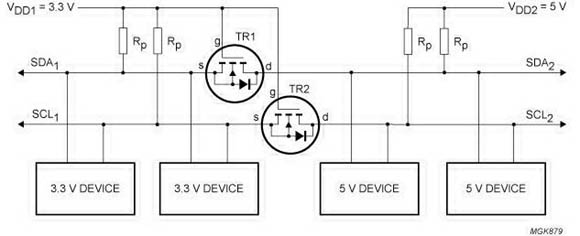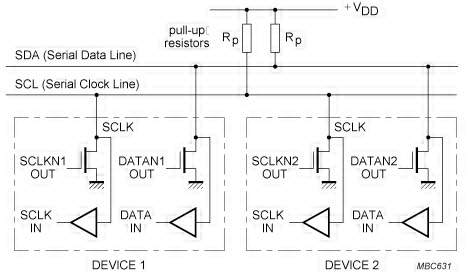About I2C-Bus
What is the I2C-bus?
![[Block Diagram]](../assets/images/MBC645.JPG) In modern electronic systems there are a number of peripheral ICs that have to communicate with
each other and the outside world. To maximize hardware efficiency and simplify circuit design, Philips
developed a simple bi-directional 2-wire, serial data (SDA) and serial clock (SCL) bus for inter-IC control. This I2C-bus supports any IC fabrication process and, with the extremely broad range of
I2C-compatible chips from Philips and other suppliers, it has become the worldwide industry standard proprietary control bus.
In modern electronic systems there are a number of peripheral ICs that have to communicate with
each other and the outside world. To maximize hardware efficiency and simplify circuit design, Philips
developed a simple bi-directional 2-wire, serial data (SDA) and serial clock (SCL) bus for inter-IC control. This I2C-bus supports any IC fabrication process and, with the extremely broad range of
I2C-compatible chips from Philips and other suppliers, it has become the worldwide industry standard proprietary control bus.
Each device is recognized by a unique address and can operate as either a receiver-only device (e.g.
an LCD driver or a transmitter with the capability to both receive and send information (such as
memory). Transmitters and/or receivers can operate in either master or slave mode, depending on whether the chip has to initiate a data transfer or is only addressed. I2C is a multi-master bus, i.e. it can be controlled by more than one IC connected to it.
The basic I2C-bus, with a data transfer rate up to 100 kbits/s and 7-bit addressing, was originally
introduced nearly 20 years ago. With the rapid increase in data transfer rates, greater throughput is being demanded to ensure that ICs are not slowed by the bus; furthermore, with their increased
functionality, applications are quickly running out of address space. To enhance performance in line with these demands, the specification of the I2C-bus has been expanded to include the Fast-mode and 10-bit addressing. There is also a level-shifting enhancement allowing the I2C-bus to be used in
mixed voltage designs.
Level-shifting I2C

Philips Semiconductors has developed a simple 'level-shifting' enhancement to the standard I2C-bus,
offering fully bi-directional data transfer between I2C-devices operating from different supply
voltages. It provides an elegant solution for allowing ICs with different supply voltages to communicate and be controlled, for almost no additional design-in effort or cost.
The simple addition of two low-cost transistors, placed between the different voltage level sections of the I2C-bus, separates and transfers the logic voltage levels of the bus lines on either side of the
level-shifter. In fact, with the addition of these transistors, the I2C-bus answers all level-shifting needs
for a complete multi-supply voltage system design. This set-up also allows the level-shifter to be used to isolate a section of powered-down devices from the bus, allowing powered I2C devices to operate normally.
At the same time, the I2C-bus specification has been extended for devices operating below 2.7 V.
This extension, together with compatibility of lower and higher voltage devices provided by the bi-directional level-shifter, ensures the I2C-bus will remain the serial bus of choice for future systems
into the next century.
Fast-mode I2C

Until 1992, the I2C-bus was mainly used for the transfer of control and status information and its
originally defined bit rate of 100 kbits/s remained sufficient for this purpose. As it became a de-facto
standard, it began to be used for text and data transfer and to meet these needs, in 1992 the
specification was upgraded with a Fast-mode, supporting bit rates up to 400 kbits/s. Compatible with
Standard-mode devices, all Philips Semiconductors devices developed since 1992 have included a Fast-mode I2C-bus interface.
10-bit I2C addressing
10-bit addressing allows the use of up to 1024 additional addresses to prevent problems with the allocation of slave addresses as the number of I2C devices rapidly expands. It does not change the
format for addresses defined in the I2C-bus specification, using addresses reserved in the existing specification.
10-bit addressing does not affect the existing 7-bit addressing, allowing devices with 7-bit or 10-bit addresses to be connected to the same I2C-bus, and both types of devices can be used in a
Standard- or Fast-mode system.
I2C-bus specification
The I2C-bus specification includes full details of the standard I2C-bus interface plus specifications for
the enhancements including Fast-mode, 10-bit addressing and details on the bi-directional level shifter.
 I2C-bus specification I2C-bus specification
|

